 W
WNeedlework is decorative sewing and textile arts handicrafts. Anything that uses a needle for construction can be called needlework. Needlework may include related textile crafts such as crochet, worked with a hook, or tatting, worked with a shuttle.
 W
WAppliqué is ornamental needlework in which pieces or patches of fabric in different shapes and patterns are sewn or stuck onto a larger piece to form a picture or pattern. It is commonly used as decoration, especially on garments. The technique is accomplished either by hand stitching or machine. Appliqué is commonly practised with textiles, but the term may be applied to similar techniques used on different materials. In the context of ceramics, for example, an appliqué is a separate piece of clay added to the primary work, generally for the purpose of decoration.
 W
WThe Badding Rug is a Victorian cross-stitch needlepoint made in 1950 entirely by hand by Carolyn Badding of San Leandro, California. Measuring 12 feet by 15 feet, worked onto a canvas backing of seven strips assembled to be one piece before any stitching began, it features approximately 1,260,000 stitches in French wool.
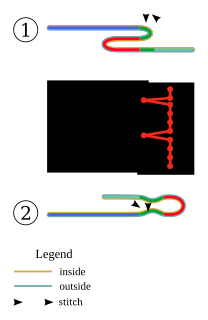 W
WA blind stitch in sewing is a method of joining two pieces of fabric so that the stitch thread is invisible, or nearly invisible. Blind stitching hides stitching under folded edges; therefore, this type of stitch can be used to create a blind hem or to join two folded edges together.
 W
WA braid is a complex structure or pattern formed by interlacing two or more strands of flexible material such as textile yarns, wire, or hair. Braids have been made for thousands of years, in many different cultures around the world, for a variety of uses.
 W
WCambric, or batiste, one of the finest and densest kinds of cloth, is a lightweight plain-weave cloth, originally from the French commune of Cambrai, woven greige, then bleached, piece-dyed and often glazed or calendered. Initially it was made of linen; later, the term came to be applied to cotton fabrics as well. Chambray is the same type of fabric, with a coloured warp and white filling; the name "chambray" replaced "cambric" in the United States in the early 19th century.
 W
WSophia Frances Anne Caulfeild was a British writer and needleworker. She wrote about religion and needlework, and frequently worked with Blanche Catherine Saward.
 W
WA choli is a blouse or a bodice-like upper garment that is commonly cut short leaving the midriff bare, it is worn along with a sari in the Indian subcontinent. The choli is also part of the ghagra choli costume in the Indian subcontinent.
 W
WCrewel embroidery, or crewelwork, is a type of surface embroidery using wool. A wide variety of different embroidery stitches are used to follow a design outline applied to the fabric. The technique is at least a thousand years old.
 W
WCrochet is a process of creating textiles by using a crochet hook to interlock loops of yarn, thread, or strands of other materials. The name is derived from the French term crochet, meaning 'small hook'. Hooks can be made from a variety of materials, such as metal, wood, bamboo, or plastic. The key difference between crochet and knitting, beyond the implements used for their production, is that each stitch in crochet is completed before the next one is begun, while knitting keeps many stitches open at a time. Some variant forms of crochet, such as Tunisian crochet and broomstick lace, do keep multiple crochet stitches open at a time.
 W
WThérèse de Dillmont was an Austrian needleworker and writer. Dillmont's Encyclopedia of Needlework (1886) has been translated into 17 languages. She owned a string of shops in European capitals and she was "one of the most important pioneers in the international and multicultural enterprise of hobby needlework in the late nineteenth century".
 W
WFelled seam, or flat-fell seam, is a seam made by placing one edge inside a folded edge of fabric, then stitching the fold down. The fold encases the raw edges protects them from fraying. The fold may be secured with a topstitch or a whipstitch. It is useful for keeping seam allowances flat and covering raw edges.
 W
WElizabeth Fry, sometimes referred to as Betsy Fry, was an English prison reformer, social reformer and, as a Quaker, a Quaker philanthropist. She has been called the "angel of prisons". Fry was a major driving force behind new legislation to make the treatment of prisoners more humane, especially those of female inmates, with the disadvantages faced by all prisoners compounded by female vulnerability disadvantage in relation to both male prisoners and warders. She was instrumental in the 1823 Gaols Act which mandated i) sex-segregation of prisons and ii) female warders for female inmates to protect them from sexual exploitation. As most Quakers since the foundation of Quakerism from 1650's, Fry kept extensive diaries in which the need to protect female prisoners from rape and sexual exploitation is explicit. She was supported in her efforts by Queen Victoria and by both Emperor Alexander I and Emperor Nicholas I of Russia and was in correspondence with both of the Imperial brothers, their wives and the Empress Mother as documented in her own journal and that of other contemporary Quakers. Journals of Stephen Grellet & William Allen She was depicted on the Bank of England £5 note, in circulation 2002-2016 and along with the female prisoners at Newgate, who benefited from her care and the campaigning work she did including giving evidence in Parliament. She worked tirelessly to ameliorate prison conditions, including the end-to-end care of women and girls deported to Botany Bay.
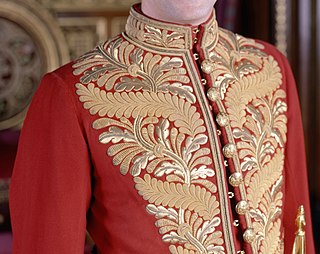 W
WGoldwork is the art of embroidery using metal threads, or threads with metal leaf wound round a normal textile thread. It is particularly prized for the way light plays on it. The term "goldwork" is used even when the threads are imitation gold, silver, or copper. The metal wires used to make the threads have never been entirely gold; they have usually been gold-coated silver (silver-gilt) or cheaper metals, and even then the "gold" often contains a very low percent of real gold. Most metal threads are available in silver and sometimes copper as well as gold; some are available in colors as well. A new coating technology however enables the direct coating of 24K gold on a filament yarn without any other metal or adhesive layer underneath.
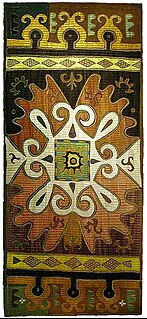 W
WKaitag textiles are an unusual embroidered textile art form from the Kaytagsky District of southeast Dagestan, Russia, inhabited mainly by Dargins and Kumyks. Kaitag textiles are of simple construction, being laid and couched silk-floss embroidery on a cotton ground. The designs are often in the style of classical Safavid Persian art, sometimes illustrating horsemen and hunting scenes. Abstract Kaitag designs have been compared to those of Matisse and Paul Klee, though it is unlikely that either artist ever saw a Kaitag textile. Surviving examples are mostly from the 17th and 18th centuries. These embroideries were apparently made for local use in weddings, funerals, and for cradle trappings. The traditional Kaitag art of embroidery was reportedly stamped out under Soviet rule.
 W
WMosaic stitch is the simplest diagonal stitch used in needlepoint.
 W
WThe Oxburgh Hangings are needlework hangings that are held in Oxburgh Hall, made by Mary, Queen of Scots and Bess of Hardwick. The hangings were made between the years 1570 and approximately 1585. An accomplished needlewoman, Bess of Hardwick joined Mary at Chatsworth House for extended periods in 1569, 1570, and 1571, during which time they worked together on the hangings. At that time Mary was imprisoned, in the custody of the Earl of Shrewsbury. The hangings' design was devised at her request. The Oxburgh Hangings consist of green velvet hangings, each with a square centerpiece with octagonal panels of emblems of plants and animals surrounding it. The hangings have been made into a wall hanging, two bed curtains and a valance, although these were probably not the original arrangement of the needlework, but instead most likely an arrangement sewn together in the late 17th century. There is also a group of 33 embroideries which are the remains of another hanging. The panels in the hangings, of which there are over a hundred, were made in cross stitch on canvas and applied to a green velvet background, and the designs of the panels were mostly based on four continental emblem books which Mary had; the panel designs were copied from wood-cut illustrations by well-known authors such as Claude Paradin, Conrad Gessner, and Pierre Belon. Some of the panels' emblems include a phoenix, and a dragon and a unicorn. The panels made by Mary have her monogram, the letters MA superimposed on the Greek letter phi, and the panels made by Bess have the initials ES.
 W
WA parzenica is a heart-shaped pattern of a traditional handicraft characteristic of the decorative art of the Polish highlanders, often found embroidered on the upper front side of men's trousers.
 W
WPatchwork or "pieced work" is a form of needlework that involves sewing together pieces of fabric into a larger design. The larger design is usually based on repeating patterns built up with different fabric shapes. These shapes are carefully measured and cut, basic geometric shapes making them easy to piece together.
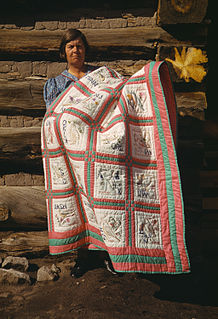 W
WA patchwork quilt is a quilt in which the top layer may consist of pieces of fabric sewn together to form a design. Originally, this was to make full use of leftover scraps of fabric, but now fabric is often bought specially for a specific design. Fabrics are now often sold in quarter meters. A "fat quarter" is one square meter folded into four and cut along the folds, thus giving a relatively square piece of fabric 50 cm on a side, as opposed to buying a quarter of a meter off the roll, resulting in a long thin piece that is only 25 cm wide.
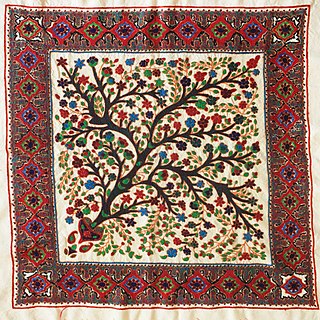 W
WPateh is an Iranian traditional needlework folk art. It originated in and is largely associated with Kerman province, where it is produced by women. A wide piece of wool fabric (ariz) is needleworked with colored thread.
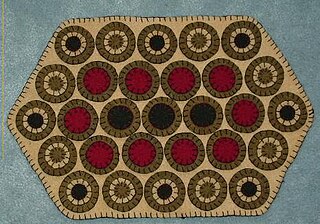 W
WA penny rug is a decoration made of stitched together coin shaped fabric scraps.
 W
WA pick stitch in sewing is a simple running stitch that catches only a few threads of the fabric, showing very little of the thread on the right side of the garment. It is also sometimes known as "stab stitch".
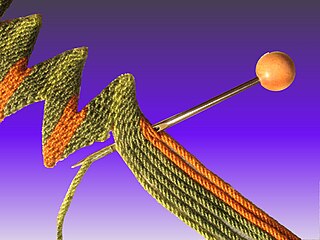 W
WPly-split braiding is a technique where one twisted cord ("splitter") passes through another twisted cord or cords splitting the plies of the latter cords. This is unlike weaving or many forms of braiding where cloth is formed by threads interlacing in an over-under sequence. Pattern is formed by cord color, and splitting order.
 W
WQuilting is the term given to the process of joining a minimum of three layers of fabric together either through stitching manually by hand using a needle and thread, or mechanically with a sewing machine or specialised longarm quilting system. An array of stitches is passed through all layers of the fabric to create a three dimensional padded surface. The three layers are typically referred to as the top fabric or quilt top, batting or insulating material and the backing.
 W
WIn sewing, shirring is two or more rows of gathers that are used to decorate parts of garments, usually the sleeves, bodice or yoke. The term is also sometimes used to refer to the pleats seen in stage curtains.
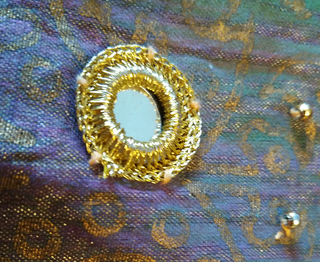 W
WShisheh or abhla bharat embroidery, or mirror-work, is a type of embroidery which attaches small pieces of mirrors or reflective metal to fabric. Mirror embroidery is common throughout Asia, and today can be found in the traditional embroidery of the Indian subcontinent, Afghanistan, China, and Indonesia.
 W
WIn needlework, a slip is a design representing a cutting or specimen of a plant, usually with flowers or fruit and leaves on a stem. Most often, slip refers to a plant design stitched in canvaswork (pettipoint), cut out, and applied to a woven background fabric. By extension, slip may also mean any embroidered or canvaswork motif, floral or not, mounted to fabric in this way.
 W
WTatting is a technique for handcrafting a particularly durable lace from a series of knots and loops. Tatting can be used to make lace edging as well as doilies, collars, accessories such as earrings and necklaces, and other decorative pieces. The lace is formed by a pattern of rings and chains formed from a series of cow hitch or half-hitch knots, called double stitches, over a core thread. Gaps can be left between the stitches to form picots, which are used for practical construction as well as decorative effect.
 W
WErnest Frederic Graham Thesiger, CBE was an English stage and film actor. He is noted for his performance as Doctor Septimus Pretorius in James Whale's film, Bride of Frankenstein (1935).
 W
WUkrainian embroidery occupies an important place among the various branches of Ukrainian decorative arts. Embroidery has a rich history in Ukraine, and has long appeared in Ukrainian folk dress as well as played a part in traditional Ukrainian weddings and other celebrations. Appearing all across the country, Ukrainian embroidery varies depending on the region of origin. From Poltava, Kyiv, and Chernihiv in the east, to Volyn and Polissia in the northwest, to Bukovyna, and the Hutsul area in the southwest, the designs have a long history which defines its ornamental motifs and compositions, as well as its favorite choice of colors and types of stitches.
 W
WEliza Warren née Jervis (1810–1900) was an English writer on needlework and household management, and editor of the Ladies' Treasury magazine. She was best-known professionally by the pen-name Mrs. Warren, but after a second marriage was also known as Eliza Francis and Eliza Warren Francis.